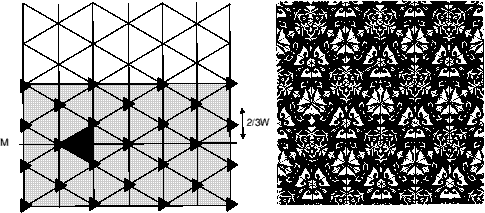
There are 2 reviews in this issue:
Book Review (1) Geometric symmetry in patterns and tiling
Title 'Geometric symmetry in patterns and tilings'
Author Clare E.Horne
Publisher Woodhead Publishing 23 October 2000 £95 US $157 €157
ISBN 1 75573 492 3 256 pages hardback size 215 x 303mm
Introductory text books of crystallography often contain a short chapter on the 17 plane groups but they rarely have space to go into detailed explanations and give illustrations of patterns of each type, before going on to the more complex three-dimensional space groups. This can leave some students unable to understand the subtleties of the more complex groups. This book could be an excellent reference work for a library where students of crystallography (or those studying it as part of courses in chemistry, materials science, earth sciences etc. ) can study the two dimensional patterns in greater detail to become familiar with the symmetry and other operations involved in their production.
There are 6 chapters:
The author is a mathematician who gained her PhD from the University of
Leeds in the combined disciplines of mathematics and design. She thinks that
good textile designers intuitively understand that their patterns are more
satisfying if they obey the geometric symmetry and translation rules
summarised in the 17 plane groups so she has written this book in an attempt
to help all designers to improve their work by a better
understanding of the geometry. She assumes that designers have no formal
mathematical training and tries to explain from first principles how each
plane group is formed by translation, rotation and reflection. The usual
crystallographic notation is used for the groups and methods are given for
the construction of designs based on each group.

Example of part of Fig 2.47 Construction of the symmetry group p3m1.
The left part shows the mirror planes and the usual triangular symbol for points of rotational symmetry 3; the larger black triangle shows the size of the 'design unit', The right part of the diagram shows the result of replicating this unit over the whole area, with the mirror lines still drawn in it. The grey shaded area shows the size of the pattern repeat.
The content of this book makes it an excellent teaching aid, particularly for those students with little mathematical training. Unfortunately, there are problems of poor layout on the page and in the reproduction of the figures which I did not expect in such an expensive book.
Kate Crennell
January 2001
Mini-review - 'Nanotechnology'
a 'Technical Brief' from the Institute of Physics
The Institute of Physics has produced a 20 page booklet on "Nanotechnology Mechanical and Electronic Systems on a Molecular Scale" ISBN 07503 0749 8.
It is the first in a new series of Briefs designed to provide technical
updates on current applications of physics targeted at the non-specialist.
This one is a useful description of the 'state-of-the art' in
nanotechnology; a term which means different things to different people;
this brief focusses on the manufacture of nanoscopic electronic and
mechanical systems by molecular assembly. There is no attempt to cover
making designer proteins or the wide use of nanotechnology in materials
development, although the authors realise that perhaps some of the most
promising lines of development come in areas which span these boundaries.
The sections are:
There are plemty of illustrations and a page of 'Further reading' both in journals and on the Internet.
Two general references are:
The one on Nanotubes at http://www.pa.msu.edu/cmp/csc/nanotube.html has links to Richard Smalley's home page where you can read his 1996 article From Balls to Tubes to Ropes: New Materials from Carbon a very readable account of the discovery of carbon nanotubes and their subsequent development.
This interesting booklet is available free to members of the
Institute of Physics just send an email to
[email protected] quoting your membership number.
The price to non-members is £7.50.
Order from Emma Woods, Institue of Physics, 76 Portland Place, London W1B 1NT
Kate Crennell
14 November 2000
Page last updated 14 December 2001
 Click here to return to BCA homepage
Click here to return to BCA homepage